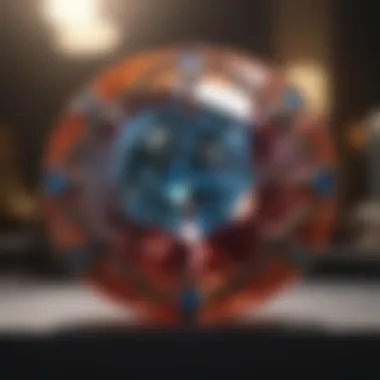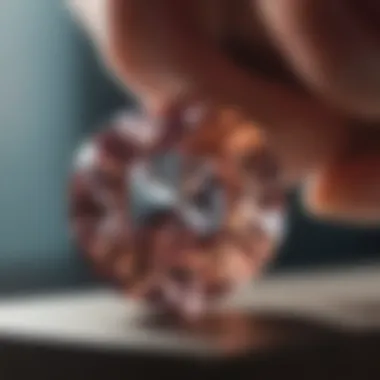Unveiling the Brilliance: A Deep Dive into Gem Cutting Wheels


Overview of Gemstones and Minerals
Gem cutting wheels play a pivotal role in revealing the true brilliance of gemstones, a process that has captivated artisans and enthusiasts for centuries. The history of using gemstones and minerals dates back to ancient civilizations, where these precious rocks symbolized wealth, power, and spirituality. Across different cultures and societies, gemstones have held significant meanings and have been revered for their beauty and rarity.
Gemstone Formation and Properties
Understanding the formation process of gemstones unveils the natural wonders of how these exquisite rocks are created deep within the Earth's crust. Gems are born through a combination of intense pressure, heat, and mineral composition over millions of years. The properties that define gemstones include their crystalline structure, refractive index, hardness, and specific gravity. Gemstones are classified based on various characteristics, such as color, hardness on the Mohs scale, and luster levels, which determine their visual appeal and durability.
Types of Gemstones
Diving into the realm of gemstones reveals a distinction between precious and semi-precious varieties, each carrying its unique allure and value. While precious stones like diamonds, rubies, emeralds, and sapphires stand out for their rarity and price, semi-precious gems like amethyst, turquoise, garnet, and topaz offer a diverse palette of colors and affordability. Exploring common gemstone varieties showcases a vast spectrum of options, ranging from vibrant red rubies to serene blue aquamarines. Additionally, exotic and rare gemstones add a touch of mystery and exclusivity to the world of gemology.
Identifying and Evaluating Gemstones
Delving into the realm of gemstone evaluation unveils the intricate factors that influence their monetary worth and desirability. Expert gemologists employ a range of techniques in identifying gemstones, including microscopy, spectroscopy, and gemological instruments. Evaluating gemstone quality involves scrutinizing factors such as color purity, clarity, cut precision, and carat weight. Assessing gemstone value considers external aspects like market demand, rarity, treatment processes, and historical significance, all of which contribute to determining the overall worth of a gemstone.
Caring for Gemstones


Ensuring the longevity and radiance of gemstones involves proper care and maintenance to preserve their innate beauty. Cleaning and storing gemstones correctly safeguard them against damage and discoloration. Avoiding common mistakes, such as exposing gems to harsh chemicals or extreme temperatures, is crucial in maintaining their luster and integrity. Offering specific care tips for different gem types is essential, as each gemstone possesses unique characteristics that demand tailored preservation methods.
Introduction
Gem cutting wheels form a vital component in the intricate realm of gem cutting, playing a fundamental role in unveiling the inherent brilliance of gemstones. Their significance lies in the precision and finesse they lend to the process, allowing gem artisans to refine raw materials into dazzling works of art. Understanding the nuances of gem cutting wheels is essential for anyone venturing into the world of gemstone faceting, as these tools can make a monumental difference in the final outcome of a cut gem. The Introduction section sets the stage for a detailed exploration of the functionalities, types, and applications of gem cutting wheels.
Understanding Gem Cutting Wheels
Gem cutting wheels, also known as lapidary wheels, are specialized tools designed for shaping, grinding, and polishing gemstones. What Are Gem Cutting Wheels? These wheels are comprised of abrasive materials that vary in hardness, with diamond, silicon carbide, and resin being common choices. The selected material determines the wheel's cutting properties and efficiency in shaping gemstones. Importance in Gem Cutting Process Gem cutting wheels are indispensable in the gemstone faceting process, responsible for creating intricate facets and reflective surfaces on gems. Their ability to precisely shape gemstones according to desired angles and proportions makes them essential tools for achieving the brilliance and fire that characterize well-cut gemstones.
Types of Gem Cutting Wheels
Diamond Grinding Wheels Diamond grinding wheels are renowned for their exceptional hardness and durability, making them ideal for shaping and polishing the hardest gemstones. Their unique feature lies in their ability to maintain sharp edges throughout prolonged use, ensuring consistent performance in cutting various gem materials. Silicon Carbide Wheels Silicon carbide wheels are valued for their versatility in grinding both hard and soft gemstones, offering a balance between efficiency and affordability. The key characteristic of silicon carbide wheels is their capacity to handle different gemstone hardness levels without excessive wear or heat generation.
Factors Influencing Gem Cutting Wheel Selection
Gemstone Hardness Gemstone hardness plays a crucial role in determining the most suitable cutting wheel for the faceting process. Harder gemstones require diamond grinding wheels for effective shaping, while softer gems may be cut with silicon carbide wheels. Desired Cut Style The desired cut style, whether traditional or modern, influences the choice of gem cutting wheel, with diamond wheels preferred for precision cuts and intricate designs. Precision Requirements Precision requirements dictate the grit size and wheel type needed for achieving specific facet angles and surface finishes.
Choosing the Right Gem Cutting Wheel


Matching Wheel to Gemstone Type Matching the wheel material to the gemstone type ensures optimal cutting efficiency and prevents damage to the stone's structure. Diamond wheels are preferred for hard gemstones like diamonds and sapphires, while softer stones like opals are best cut with resin wheels. Grain Size and Grit Selection The grain size and grit of the cutting wheel impact the speed and quality of the cutting process, with finer grits producing smoother surfaces and higher sheen. Compatibility with Cutting Equipment Ensuring compatibility between the cutting wheel and the faceting equipment is essential for achieving precise cuts and maximizing operational efficiency.
Techniques in Gem Cutting Using Wheels
Faceting Process Overview The faceting process involves multiple steps, including preforming, shaping, and polishing, each requiring specific wheel types for optimal results. Diamond wheels are commonly used for initial shaping, while finer grit wheels are employed for polishing and refining facet surfaces. Grinding and Polishing Methods Grinding and polishing methods vary depending on the gemstone material and desired finish, with silicon carbide wheels providing efficient material removal and resin wheels delivering high-gloss polishing effects. Safety Precautions Adhering to safety protocols during gem cutting is paramount to prevent injuries and safeguard the integrity of both the gemstone and the cutter. Utilizing appropriate safety gear and following correct operational procedures are crucial for a secure cutting environment.
Maintenance and Care of Gem Cutting Wheels
Cleaning and Storage Tips Proper maintenance of gem cutting wheels prolongs their lifespan and ensures consistent cutting performance. Cleaning the wheels regularly to remove debris and using appropriate storage methods minimizes wear and maintains cutting efficiency. Replacing and Reshaping Wheels Periodic replacement and reshaping of gem cutting wheels are essential to prevent dulling and maintain their cutting precision. Identifying signs of wear and addressing them promptly can prevent damage to the gemstone during cutting processes.
Common Issues and Troubleshooting
Gem cutting processes may encounter issues such as wheel imbalance, erratic cutting patterns, or excessive heat generation, requiring troubleshooting actions for resolution. Understanding common problems and their potential solutions is crucial for maintaining cutting quality and efficiency.
Innovations in Gem Cutting Technology
Automated Cutting Systems Automated cutting systems leverage technology to enhance cutting precision and efficiency, enabling gem cutters to achieve complex designs with greater ease. These systems streamline the cutting process, reducing human error and increasing production capacity.
Computer-Aided Design Software


Computer-aided design software revolutionizes the gem cutting process by providing virtual modeling tools for designing intricate gemstone cuts. This software allows cutters to visualize and refine cuts before actual implementation, optimizing the use of gem cutting wheels for precise results.
Industry Trends and Future Prospects
Keeping abreast of industry trends and technological advancements is essential for staying competitive in the gem cutting sector. Embracing innovations such as automated cutting systems and digital design tools can enhance operational efficiency and open new avenues for creative gem cutting applications.
Exploring Gem Cutting Wheel Applications
Jewelry Making Gem cutting wheels are indispensable in jewelry making, enabling craftsmen to create custom-cut gemstones for bespoke jewelry pieces. The precision and versatility of these wheels cater to the diverse cutting requirements of jewelry designers, ensuring the production of exquisite pieces.
Industrial Cutting Applications
Beyond jewelry making, gem cutting wheels find extensive utility in industrial applications such as precision machining and fabrication. Industries rely on these tools for cutting and shaping a wide range of materials, showcasing the adaptability and robustness of gem cutting technology.
Artistic and Decorative Use
Artists and designers utilize gem cutting wheels for crafting decorative pieces and artistic installations, incorporating cut gemstones into various creative projects. The ability to shape gemstones according to intricate designs expands the possibilities of artistic expression in decorative arts.
Ethical and Sustainable Practices in Gem Cutting
Fostering ethical practices in gem cutting involves sourcing gemstones responsibly, considering the environmental impact of cutting processes, and adhering to fair trade standards. Embracing sustainable approaches ensures the longevity of the gem cutting industry and promotes ethical standards across the supply chain.
Conclusion
The exploration of gem cutting wheels unveils a world of precision, innovation, and creativity, essential for transforming rough gemstones into exquisite works of art. Key takeaways from this guide include the importance of selecting the right cutting wheel for specific gem materials, maintaining cutting equipment for longevity, and embracing technological advancements for enhanced cutting precision. Looking ahead, the future of gem cutting wheels holds promise for continued advancements in cutting technology, opening new horizons for gemstone craftsmanship and design.







